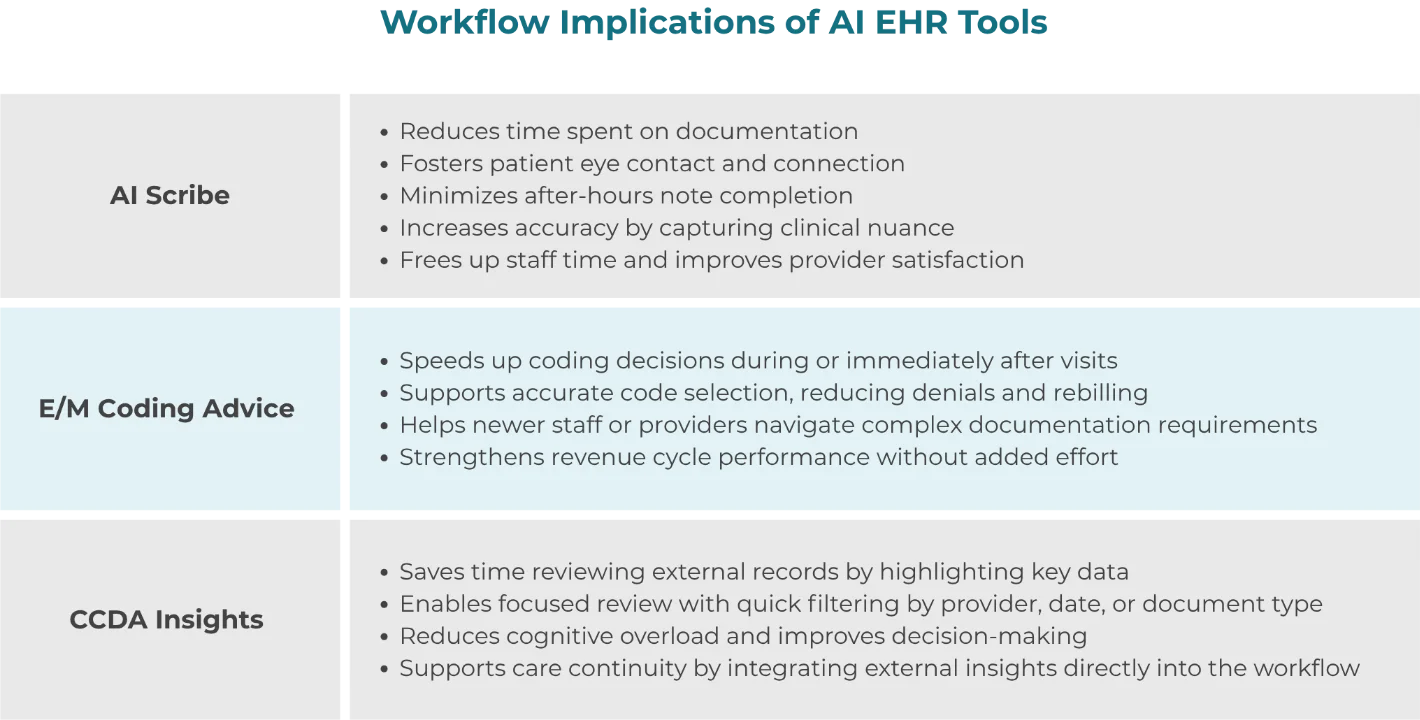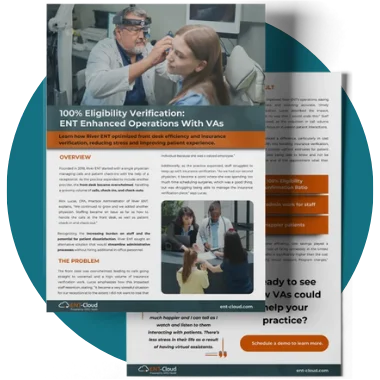Key Takeaways
- ENT EHR systems with AI reduce the documentation burden and improve coding accuracy.
- Cloud-based platforms help otolaryngologists scale while staying HIPAA compliant and MIPS-ready.
- AI tools support growth by improving operational efficiency and staff satisfaction.
- Plan a smooth switch to an ENT-specific EHR to modernize without disruption.
Otolaryngology practices face an increasing number of operational demands. Whether you’re a solo ENT provider or managing a multi-provider clinic, you’ve likely felt the strain—long hours spent documenting, missed billing opportunities, legacy software reducing productivity, and staff hesitant to embrace new systems.
At the same time, patients expect a seamless digital experience, and healthcare regulations continue to evolve. Instead of constantly putting out small fires just to get by, many ENT practices are choosing smarter, AI-enhanced EHR systems: an ENT EHR with AI.
Whether you’re integrating your first AI features or reworking your automated processes, smart systems can blend cloud-based flexibility with AI-driven automation. The right solutions will elevate operations on a broad scale, optimize revenue cycles, and help your team focus on delivering excellent care. Here’s what you need to know.
Table of Contents
AI Tools for Otolaryngologists Reduce Admin Overload
For example, natural language processing (NLP) can transcribe provider notes in real time and auto-fill encounter templates during the visit. Without the requirement to loop back and finish notes later, documentation is captured clearly and accurately in the moment and providers reclaim some time.
Other AI tools support smart intake forms and insurance verification to overhaul appointment scheduling and medication refill requests—without interrupting front desk staff.
The result? More efficient days, reduced staff burnout, and greater capacity to focus on complex cases that require the provider’s full attention.
ENT-Specific Workflows Matter—A Lot
Generic EHRs rarely meet the nuanced needs of an ENT practice. Whether you’re conducting audiograms, managing chronic sinusitis, or preparing for in-office procedures, your workflows are unique. That’s why ENT-specific EHR systems with AI features are essential.
Customizable templates for common ENT visit types, integration with laryngoscopy and audiology results, and built-in support for allergy tracking and surgical planning allow for precise, streamlined documentation.
AI can recommend common CPT or ICD-10 codes based on your encounter content and highlight documentation gaps that may delay billing or affect compliance. AI surfaces insights that help clinicians make faster clinical connections without hours of digging through medical history and charts. These benefits are significant—streamlining documentation while supporting clinical precision.
Cut the Confusion: Choose the Right Cloud-Based EHR With Confidence
For many ENT providers, selecting and integrating a new EHR system can feel overwhelming. With so many options and unclear promises, it’s easy to delay upgrades out of fear that the process will disrupt daily operations—or demand IT resources you don’t have. While the unknown can seem intimidating, modern EHRs like ENT-Cloud are designed with simplicity and security in mind.
Leading ENT EHR providers now deliver clear implementation plans, intuitive interfaces, and responsive support that guides you through setup, data migration, and customization. You don’t need a large infrastructure team to adopt a smarter system. Cloud-based platforms minimize hardware requirements, automate updates, and maintain HIPAA compliance—no IT team required
With ENT-specific workflows and flexible configurations, the right system removes the guesswork from modernization. Instead of working around your software, your software works for you—and scales as you grow.

Smoother MIPS and Compliance Readiness
Among the many tools that directly impact each team member’s day, a cloud-based EHR for small ENT practices can help practice staff with scarce resources stay compliant. MIPS reporting, prior authorizations, and HIPAA security are all major time sinks—especially if your current system requires constant workarounds or manual submissions. An AI-enhanced ENT EHR streamlines compliance by automating key parts of the reporting process.
EHRs with advanced automation can:
- Track MIPS performance indicators in real time.
- Autofill and flag incomplete fields for quality metrics.
- Guide documentation during exams to ensure all compliance boxes are checked.
With these tools in place, your team avoids last-minute reporting stress, reduces billing delays, and stays ahead of payer requirements—all while maintaining accurate, defensible records.
Staff Adoption Improves With EHRs That Work Like They Do
One common challenge during EHR modernization and process adjustments is staff resistance. Schedulers, billers, and medical assistants may be concerned about learning a new system—especially if the last software change made their work harder.
Modern ENT EHRs are built to address this challenge directly. Role-based dashboards show only the tools each user needs, minimizing confusion and making the system easier to learn. AI tools for otolaryngologists can also help new team members onboard quickly by guiding task flows and showcasing the most relevant information in real time.
And when your EHR reduces repetitive work—like scanning for missing codes or uploading documents—staff morale improves. That means more consistency, better retention, and less friction across the board.
Smarter Systems, Stronger Practices
Adopting an ENT EHR with AI is a strategic step toward long-term success. More than a tech upgrade, integrating automations and smart processes is a strategic tool for long-term success, building a top team, and taking control of your daily operations. It helps reduce admin overhead, supports accurate documentation, and makes compliance more manageable—all while freeing up time for what matters most: patient care.
Whether you’re replacing outdated software or adopting AI EHR tools for the first time, look for a partner that understands the unique needs of ENT providers. With the right system in place, your practice can run smarter, grow faster, and give every staff member—from scheduler to practitioner—the tools they need to succeed.











